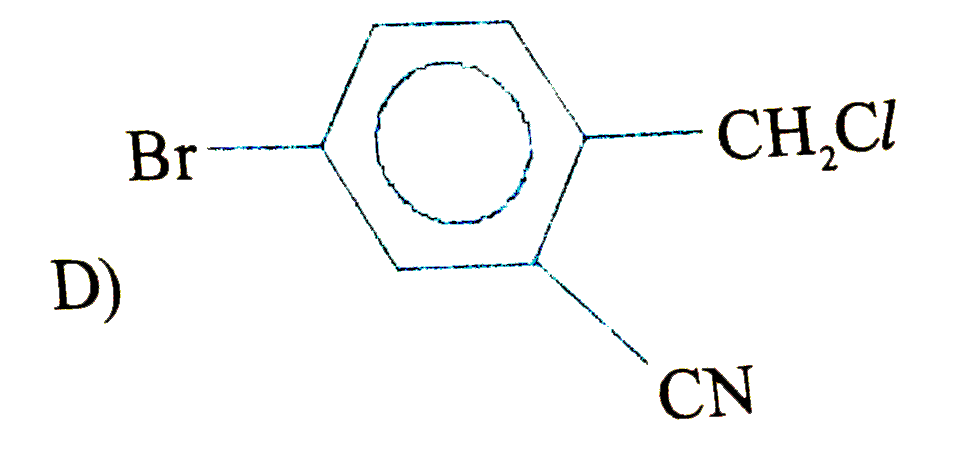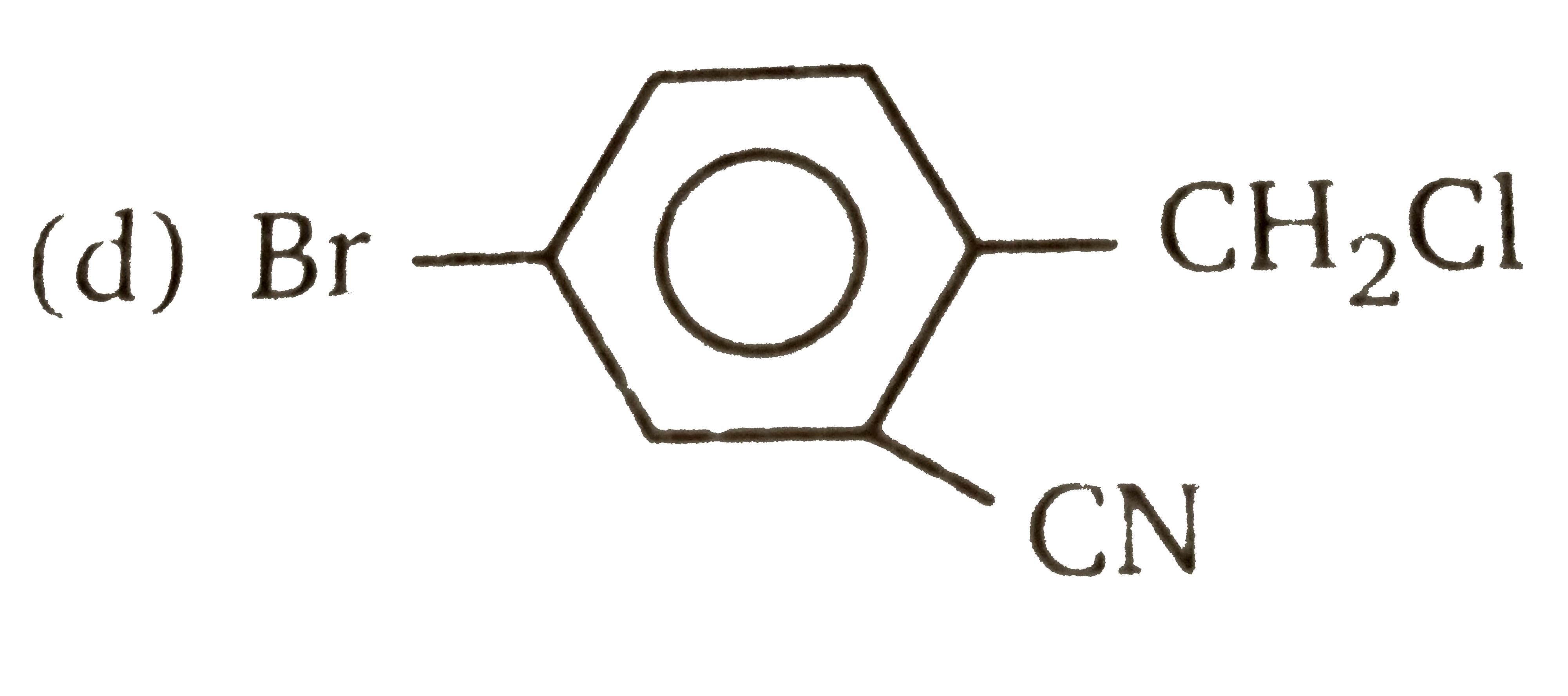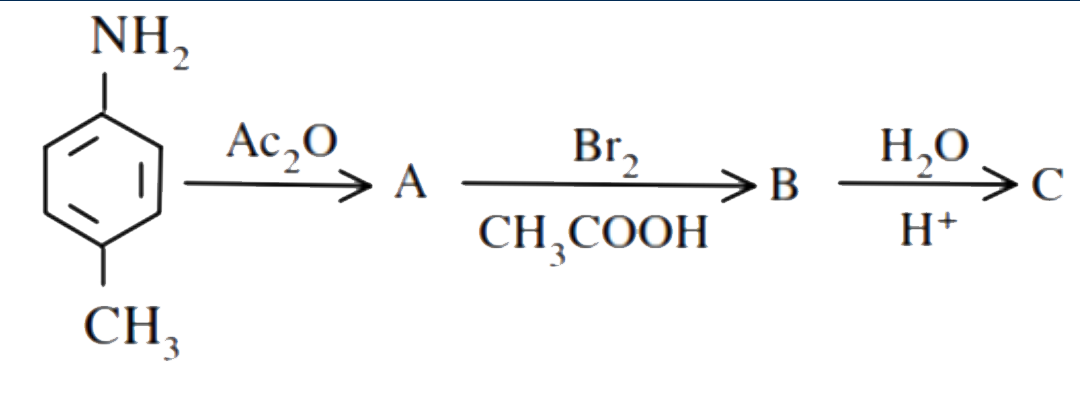What product would be obtained from the reaction of cyclopropane with Cl2 in the presence of FeCl3?
1,2-dichloropropane
1,2-dichlorocyclopropane
1,3-dichloropropane
1,1-dichlropropane
The correct Answer is:3
To determine the product obtained from the reaction of cyclopropane with Cl₂ in the presence of FeCl₃, we can follow these steps:
1. Identify the Reactants:
- The reactants are cyclopropane (C₃H₆) and chlorine gas (Cl₂) in the presence of iron(III) chloride (FeCl₃).
2. Understand the Role of FeCl₃:
- FeCl₃ acts as a Lewis acid and helps generate a more reactive electrophile from Cl₂. It facilitates the formation of Cl⁺ (chloronium ion) and Cl⁻ (chloride ion) which can react with cyclopropane.
3. Formation of Electrophile:
- In the presence of FeCl₃, Cl₂ dissociates to form Cl⁺ and Cl⁻:
Cl2+FeCl3→Cl++FeCl−4
- Here, Cl⁺ is the electrophile that will react with cyclopropane.
4. Cyclopropane Structure:
- Cyclopropane has a strained three-membered ring structure with sp³ hybridized carbons. The bond angles are approximately 60 degrees, which leads to significant ring strain.
5. Electrophilic Attack:
- The electrophile Cl⁺ attacks one of the carbon atoms in cyclopropane, leading to the opening of the ring. The C-C bond breaks due to the ring strain, resulting in a carbocation intermediate:
CyclopropaneCl+−−→CH+2−CH2−CH2
6. Formation of the Product:
- The Cl⁻ ion generated from the dissociation of Cl₂ can now attack the carbocation formed after the ring opening. The final product will be a chain of three carbon atoms (propane) with chlorine substituents:
CH2−CH−CH2 with Cl on both ends
7. Naming the Product:
- The product has two chlorine atoms attached to the first and third carbon of the propane chain. Thus, the compound is named 1,3-dichloropropane.
Final Answer:
The product obtained from the reaction of cyclopropane with Cl₂ in the presence of FeCl₃ is 1,3-dichloropropane.
---
- The reactants are cyclopropane (C₃H₆) and chlorine gas (Cl₂) in the presence of iron(III) chloride (FeCl₃).
- FeCl₃ acts as a Lewis acid and helps generate a more reactive electrophile from Cl₂. It facilitates the formation of Cl⁺ (chloronium ion) and Cl⁻ (chloride ion) which can react with cyclopropane.
- In the presence of FeCl₃, Cl₂ dissociates to form Cl⁺ and Cl⁻:
Cl2+FeCl3→Cl++FeCl−4
- Here, Cl⁺ is the electrophile that will react with cyclopropane.
- Cyclopropane has a strained three-membered ring structure with sp³ hybridized carbons. The bond angles are approximately 60 degrees, which leads to significant ring strain.
- The electrophile Cl⁺ attacks one of the carbon atoms in cyclopropane, leading to the opening of the ring. The C-C bond breaks due to the ring strain, resulting in a carbocation intermediate:
CyclopropaneCl+−−→CH+2−CH2−CH2
- The Cl⁻ ion generated from the dissociation of Cl₂ can now attack the carbocation formed after the ring opening. The final product will be a chain of three carbon atoms (propane) with chlorine substituents:
CH2−CH−CH2 with Cl on both ends
- The product has two chlorine atoms attached to the first and third carbon of the propane chain. Thus, the compound is named 1,3-dichloropropane.
The product obtained from the reaction of cyclopropane with Cl₂ in the presence of FeCl₃ is 1,3-dichloropropane.
Topper's Solved these Questions
- HYDROCARBONSBOOK - AAKASH INSTITUTECHAPTER - HYDROCARBONSEXERCISE - TRY YOURSELF
78 Videos
- HYDROCARBONSBOOK - AAKASH INSTITUTECHAPTER - HYDROCARBONSEXERCISE - Exercise
50 Videos
- HYDROCARBONSBOOK - AAKASH INSTITUTECHAPTER - HYDROCARBONSEXERCISE - SECTION-I SUBJECTIVE QUESTIONS
9 Videos
- HALOALKANES AND HALOARENES BOOK - AAKASH INSTITUTECHAPTER - HALOALKANES AND HALOARENES EXERCISE - ASSIGNMENT SECTION -D
15 Videos
- HYDROGENBOOK - AAKASH INSTITUTECHAPTER - HYDROGENEXERCISE - ASSIGNMENT (SECTION - D) (Assertion-Reason Type question)
15 Videos
Similar Questions
Knowledge Check
The product obtained from the reaction
 A
A B
B C
C D
D
The reactions of tolunce with Cl2 in pressnce of FeCl3 gives :
Abenzoyl chorideBbenzyl chlorideCo- and p- bromophenolDm-chlorotolueneThe product obtained from the reaction is:
 A
A B
B C
C D
D
The reaction of toluene with Cl2 in presence of FeCl3 gives predominantly
View SolutionThe reaction of toluene with Cl2 in presence of FeCl3 gives predominantly :
View SolutionThe reaction of toluene with Cl2 in presence of FeCl3 gives predominantly :
View SolutionThe reaction of toluene with chlorine in the presence of FeCl3 gives predominantly
View SolutionWhich of the following structures corresponds to the product expected from the reaction of benzene (excess) with CH2Cl2 in the presence of anhydrous AlCl3?
View Solution

